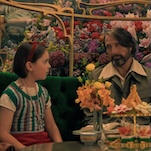Immortality is a welcome, unsettling turn to cinematic horror from the creator of Her Story
Sam Barlow and Half Mermaid's latest live-action video game is a meditation on the ways film can haunt us—figuratively, and literally

Why are we fascinated by the idea of haunted films? Return, again and again, to the idea of a spirit attaching itself to a movie—whether in film itself, or on the internet, where god knows how many creepypastas have been written about “lost episodes,” cursed movies, TV shows, and films that possess a spirit of their own? Is it an acknowledgement of how much creators put themselves into their work? Or a reckoning with the way movies can leech into our very spirits, affect us, or, for lack of a better word … haunt us?
Sam Barlow and Half Mermaid’s new game, Immortality, is all about the way film eludes our defenses, and sneaks dangerous (and possibly unwanted) emotional payloads into our souls. The first outright horror game from the creator of Her Story and Telling Lies, the game purports to be a collection of lost footage from the filmography of Marissa Marcel (Manon Gage), an actress who appeared in three films across a 40-year career—all of them unreleased. Untangling the reasons for the shuttering of each of these projects, and the reason so many people associated with them appear to have come to an unhappy end, is the bulk of the players’ duties here, ostensibly as a sort of amateur film editor jumping through the archive mostly at will.
Mechanically, Immortality will be immediately familiar to players of Barlow’s last two games, albeit with a visual twist. Where the previous games had players search out new pieces of live-action footage in their vast and hidden archives by typing in keywords in a search box, Immortality instead tasks them with selecting visual elements in the clips watched to find related ones. Interested in a background player in a scene? Take your editing window into “search mode” and click their face to be brought to a different clip in which they feature. Click a crucifix around a character’s neck, and you’ll be whisked to another clip in which a cross appears. You can even do it for certain actions—kissing, for instance, can jump you between each of the three films on offer pretty easily, given the ways sex and sexuality thread their way throughout Marcel’s fictitious filmography.
In review notes for the game, Barlow and his team talk about wanting to recreate the sensation of being a film editor, creating match cuts, playing with juxtapositions, etc. The problem with that approach, ultimately, is that your job as a player of Immortality is not to be an editor, but a detective, and clicking haphazardly between objects like this is a relatively poor way to go searching for clues. (We found ourselves missing that nostalgic text window more than once.) The biggest issue is that the clip you’re taken to when making an “edit” seems to be at least partially random; there’s no way we found to narrow your search if you’re trying to find something specific, which can lead to lots of desperate clicking of the same element, searching for a new clip to sate your curiosity. Lost in the shuffle, then, is some of the sense of hunting down a lead that was so satisfying in the two prior games, where one interesting new term or name could open up whole new angles of the story. All three of Barlow’s games, by the merit of their player-dictated pacing, have moments when the momentum can crash, but Immortality feels like it’s affected the worst by these sudden dead ends.








































